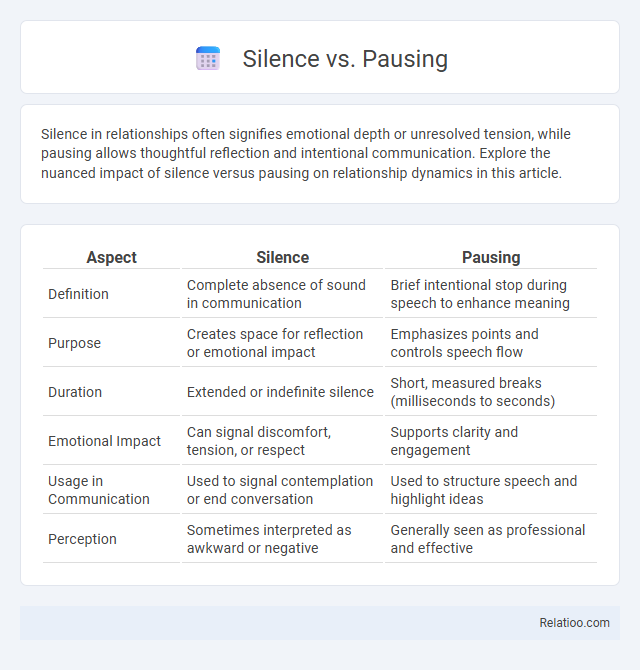Silence in relationships often signifies emotional depth or unresolved tension, while pausing allows thoughtful reflection and intentional communication. Explore the nuanced impact of silence versus pausing on relationship dynamics in this article.
Table of Comparison
| Aspect | Silence | Pausing |
|---|---|---|
| Definition | Complete absence of sound in communication | Brief intentional stop during speech to enhance meaning |
| Purpose | Creates space for reflection or emotional impact | Emphasizes points and controls speech flow |
| Duration | Extended or indefinite silence | Short, measured breaks (milliseconds to seconds) |
| Emotional Impact | Can signal discomfort, tension, or respect | Supports clarity and engagement |
| Usage in Communication | Used to signal contemplation or end conversation | Used to structure speech and highlight ideas |
| Perception | Sometimes interpreted as awkward or negative | Generally seen as professional and effective |
Understanding Silence and Pausing
Understanding silence and pausing is crucial for effective communication; silence refers to the complete absence of sound, creating a space for reflection or emotional emphasis, while pausing involves intentional breaks within speech to enhance clarity and engagement. Your ability to differentiate between these can improve conversational flow and comprehension, allowing meaningful interactions. Strategic use of silence conveys empathy and thoughtfulness, whereas pausing structures your message for better impact.
The Psychological Impact of Silence
Silence can serve as a powerful psychological tool, creating a space for reflection and emotional processing, while pauses in conversation often signal thoughtfulness or emphasize key points, enhancing communication effectiveness. Extended silence might induce feelings of discomfort or anxiety in some individuals, highlighting its impact on mental state and interpersonal dynamics. Understanding the subtle differences between silence and pauses can improve your ability to navigate social interactions and manage emotional responses.
The Power of Pausing in Communication
Pausing in communication enhances clarity and impact by giving your audience time to absorb key points and reflect on your message. Unlike silence, which can create awkward gaps, purposeful pauses demonstrate confidence and control, emphasizing important ideas without overwhelming listeners. Your strategic use of pauses can transform conversations into powerful exchanges that hold attention and foster understanding.
Silence vs Pausing: Key Differences
Silence refers to the complete absence of sound, often indicating a break or stillness in communication, while pausing involves a deliberate interruption in speech to emphasize a point, gather thoughts, or create anticipation. Pausing is an active, strategic tool used by speakers to enhance clarity and engagement, whereas silence can be passive and may convey different meanings depending on context, such as discomfort or reflection. Understanding the key differences between silence and pausing helps improve communication effectiveness by distinguishing intentional breaks from unintended lapses in dialogue.
Cultural Perspectives on Silence and Pausing
Silence and pausing hold different cultural significances, where silence often conveys respect or contemplation in East Asian cultures, while Western cultures might interpret prolonged silence as discomfort or disengagement. Pausing, on the other hand, is generally seen as a strategic communication tool across many cultures, used to emphasize points or allow reflection without negative connotations. Understanding these cultural perspectives is crucial for effective cross-cultural communication and reducing misinterpretations.
Strategic Uses of Silence in Conversation
Silence in conversation serves as a powerful strategic tool, enabling speakers to emphasize points, encourage reflection, or signal openness to input. Pausing allows for cognitive processing and emotional regulation, enhancing clarity and impact without breaking the flow of communication. Leveraging silence strategically can foster deeper understanding, create space for active listening, and influence conversational dynamics effectively.
How Pausing Improves Clarity and Emphasis
Pausing strategically during speech enhances clarity by giving listeners time to process information, reducing cognitive overload and improving comprehension. Unlike extended silence, which may cause confusion or discomfort, intentional pauses signal transitions or emphasize key points, making the message more impactful. This method leverages natural speech rhythms to highlight important ideas and maintain audience engagement effectively.
Common Misinterpretations of Silence
Silence is often misinterpreted as agreement, disinterest, or discomfort, though it may simply represent thoughtful reflection or a natural conversational break. Unlike a deliberate pause, which is consciously used to emphasize a point or allow processing time, silence can be unintended and context-dependent. Understanding these nuances helps prevent miscommunication in personal and professional interactions.
Mastering the Art of Pausing and Silence
Mastering the art of pausing and silence enhances communication by allowing your message to resonate and giving listeners time to absorb information. Effective use of silence creates emphasis, builds anticipation, and conveys confidence, making your speech more impactful. You can transform dialogues by balancing purposeful pauses with intentional silence, fostering deeper understanding and engagement.
Practical Scenarios: When to Use Silence or Pausing
In practical scenarios, silence is powerful for allowing emotional processing or emphasizing important points, while pausing is ideal for enhancing clarity and giving your audience time to absorb information. You can use silence during tense conversations to create space for reflection, whereas pausing is effective in presentations to highlight key messages and maintain audience engagement. Understanding when to apply silence versus pausing improves your communication effectiveness and helps you convey confidence.

Infographic: Silence vs Pausing
 relatioo.com
relatioo.com